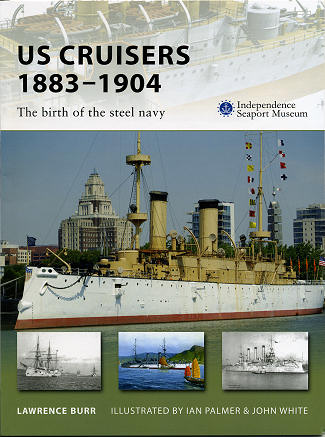 During
the Civil War, the US Navy was one of the largest in the world. However, in the
aftermath of the war, much was allowed to deteriorate or retired without
replacement. By the 1880s, the US Navy was but a ghost of its former self as the
nation's attention was drawn inward. These times were one of rampant European
Imperalist expansion into area of the Far East and Pacific. It was pretty
obvious that the US was not going to be one with its 26 ship Navy, of which only
four had metal hulls.
During
the Civil War, the US Navy was one of the largest in the world. However, in the
aftermath of the war, much was allowed to deteriorate or retired without
replacement. By the 1880s, the US Navy was but a ghost of its former self as the
nation's attention was drawn inward. These times were one of rampant European
Imperalist expansion into area of the Far East and Pacific. It was pretty
obvious that the US was not going to be one with its 26 ship Navy, of which only
four had metal hulls.
In 1881, the then Secretary of the Navy ,
William Hunt, encouraged president Chester Arthur that something had to be done.
The treasury enjoyed a surplus of funds and so it was that plans were made to
start building a modern, steel hulled Navy.
These early ships were not totally weaned
from sail power, requiring the wind to help as the US had no coaling stations
around the world as did other powers. Naturally, there were problems, as US
industry was not set up for steel hulled warships. It was through the
construction of early cruisers, albeit from British designs at first, that
American steel and weapons industry learned what was need to build world-class
warships.
Thanks to the construction of armored
cruisers during this time period, the US Navy emerged as a leader in design and
construction of modern warships.
The author takes us through all the
various ships built during this time period, highlighting the various design
features of the ships being built at that time. Both positive and negative
features of these ships are covered in some detail with these sections divided
into each year's build authorizations.
There is then a section on these ships in
action, which is basically the two major battles of the Spanish-American War at
Manila Bay and Santiago. It was thanks to these events that the US was able to
gain overseas possessions and the coaling stations so needed by a modern,
ocean-going navy.
A section on the living conditions aboard
these ships is followed by an in-depth look at one of the best and somewhat
unique ships of this class, the USS Olympia, the only ship of this class still
afloat. A full history of the Olympia is also provided, showing that this
ship had a long and distinguished career.
In addition to the superb period
photographs of these vessels, there is the artwork of Ian Palmer and John White
to further enhance the experience of reading this book. It makes for a well
rounded publication and a book that I can most highly recommend to you.
June 2008
For more on the complete line of Osprey books,
visit www.ospreypublishing.com. In the US, it is
Osprey Direct at 44-02 23rd St, Suite 219, Long Island City, NY 11101., where you can
get a catalogue of available books.
If you would like your product reviewed fairly and quickly by a
site that has nearly 400,000 visitors a month, please contact
me or see other details in the Note to
Contributors.
 During
the Civil War, the US Navy was one of the largest in the world. However, in the
aftermath of the war, much was allowed to deteriorate or retired without
replacement. By the 1880s, the US Navy was but a ghost of its former self as the
nation's attention was drawn inward. These times were one of rampant European
Imperalist expansion into area of the Far East and Pacific. It was pretty
obvious that the US was not going to be one with its 26 ship Navy, of which only
four had metal hulls.
During
the Civil War, the US Navy was one of the largest in the world. However, in the
aftermath of the war, much was allowed to deteriorate or retired without
replacement. By the 1880s, the US Navy was but a ghost of its former self as the
nation's attention was drawn inward. These times were one of rampant European
Imperalist expansion into area of the Far East and Pacific. It was pretty
obvious that the US was not going to be one with its 26 ship Navy, of which only
four had metal hulls.